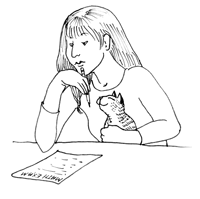STRANGE BUT TRUE- Your pet: More calming than you might realize

DRAWING BY DEBORAH DERR McCLINTOCK
Q. You and the rest of the staff at "Math for Women" are tackling some tough problems and have been encouraged to bring along a companion to the sessions for stress control. Should you take a) your spouse b) your best friend c) your dog? –J. Mead
A. Your dog would likely be the best choice to help handle any stress you might feel, says researcher Karen Allen in Psychology by David G. Myers. Many people liken a loyal dog or cat to a close family member, helping them feel calm, valued, happy. A pet can be a best friend that will love you just as you are (whether you can do the math or not), one nonjudgmental and always there for you. Thus pets even have healing power. Also Allen reports that pets have been found to increase the odds of survival after a heart attack, to relieve depression among AIDS patients, and to lower levels of blood lipids that increase cardiovascular risk.
As nursing pioneer Florence Nightingale foresaw, "A small pet animal is often an excellent companion for the sick."
Allen notes a similar de-stressing effect among harried stockbrokers who had few social contacts but had a pet at home: They exhibited only half the blood pressure rise as non-pet owners.
"For lowering blood pressure, pets are no substitute for effective drugs and exercise," she says. "But for those who enjoy animals, and especially for those who live alone, they are a healthy pleasure."
Q. You'd never guess it from its formal name "congenital generalized hypertrichosis terminalis" (CGHT), but what's the vernacular reference to this condition that has followed sufferers throughout history, fascinating people, and even packing in circus audiences? –J. Hong
A. Sometimes called "wolfman syndrome," the rare but highly heritable disorder that causes excessive dark hair across the body and face as well as enlargement of the head and facial features, reports Constance Holden in Science magazine. Researchers today have determined that CGHT victims have genetic mutations, called copy number variations, where chunks of DNA are deleted. There are at least 30 such cases in China, estimates Beijing geneticist Xue Zhang, 16 cases in just three particular families.
History's most famous "bearded lady" was Julia Pastrana, a Mexican Indian woman who danced and sang in a 19th-century traveling circus, dressed in clothes that showed off her hairy condition.
Q. Your car has maybe 250 horsepower, a locomotive around 2,500, but how about you? What's your horsepower? –G. Reeves
A. Raise 100 pounds 5 1/2 feet and you just performed 550 foot-pounds of work (100 x 5.5). Do this in a single second and you just generated 1 horsepower.
So when a top Olympic lifter "snatches" 350 pounds seven feet overhead in a second or two, he achieves a burst of up to about 4 horsepower. (A horse at top effort rates 10 or more.) Sustaining this is another matter: The average person can do about 1/5th horsepower for several minutes, a top athlete about 1/2 horsepower.
Now if you want to picture the power of your car's engine, imagine attaching it via chain-and-pulley to a platform bearing a dozen 6-ton elephants. Then— ignoring frictions, etc.– the 250 "horses" under the hood could theoretically raise the elephants a foot in about a second.
Q. Aspiring artists, can you identify what the following have in common? a) a cereal box b) a credit card c) your lover's torso. –B. Pascal
A. You could throw in flags, playing cards, football fields, TV screens, much of the work of Michelangelo and da Vinci, and the ancient Greek Parthenon as well.
All incorporate "golden rectangles," with a length about 1.6 times width. Surveys have shown that rectangles of this proportion are most pleasing to the eye, not too elongated and more interesting than a simple square.
~
Send Strange questions to brothers Bill and Rich at [email protected].
#